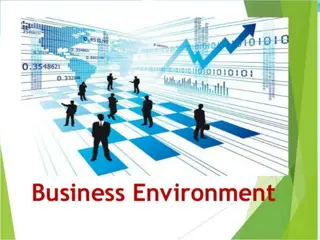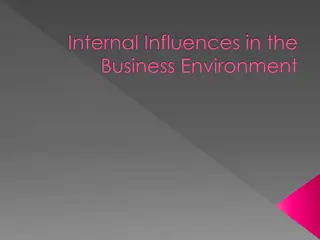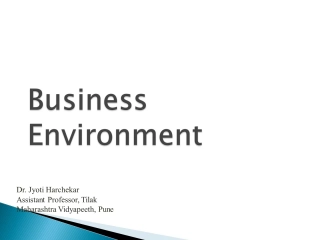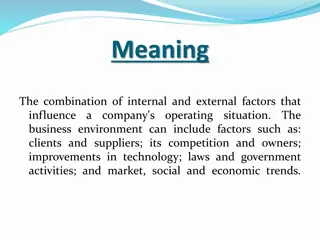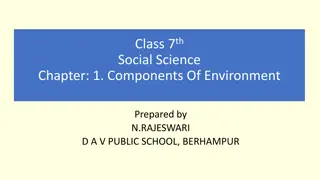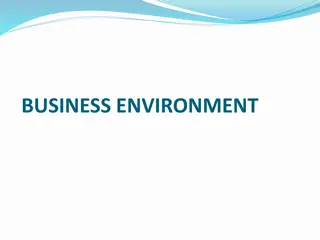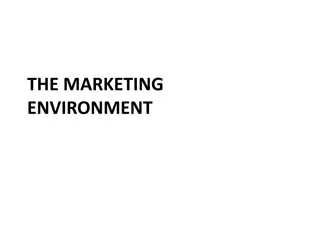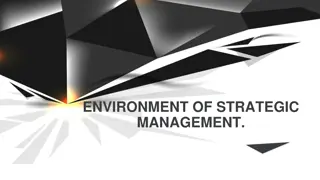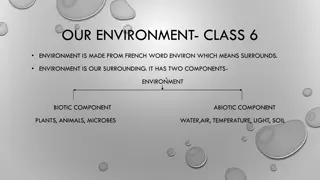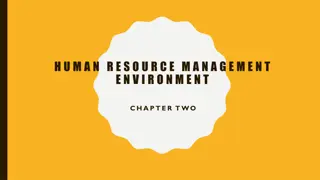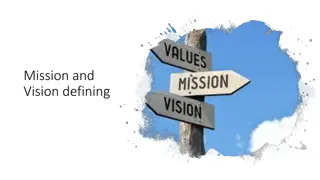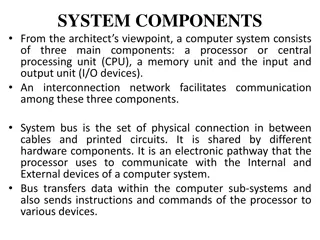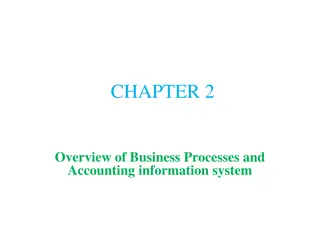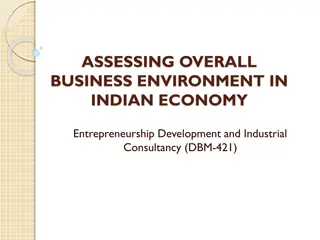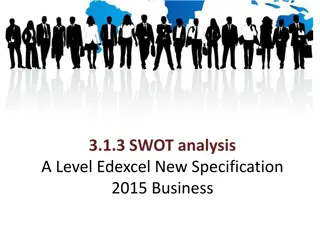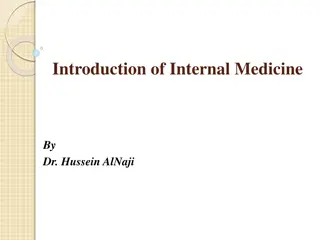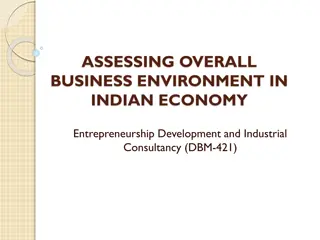Understanding the Impact of Internal Environment Components on Business Decisions
The internal environment of a business is influenced by factors like value systems, vision, management structure, internal power relationships, and human resources. These components have a direct impact on decision-making processes and organizational performance. By analyzing and understanding these internal factors, businesses can better navigate challenges and leverage opportunities in the ever-evolving competitive landscape.
- Internal environment
- Business decisions
- Management structure
- Human resources
- Organizational performance
Download Presentation

Please find below an Image/Link to download the presentation.
The content on the website is provided AS IS for your information and personal use only. It may not be sold, licensed, or shared on other websites without obtaining consent from the author. Download presentation by click this link. If you encounter any issues during the download, it is possible that the publisher has removed the file from their server.
E N D
Presentation Transcript
Environment =External +Internal Forces INFLUENCE INTERNAL EXTERNAL BETWEEN EXTERNAL AND INTERNAL ENVIRONMENT POSITIVE NEGATIVE MACRO MICRO ENVIRONMENTAL VARIABLES MUTUAL RELATIONSHIP External is beyond Control of Individual, Industrial Enterprise, and Their Management., and vary from industry to industry and country to country. A strategist looks on environment as posing threats to the firm or offering immense opportunities for exploitation.
Different Organizations use different inputs, adopt different processes, and produce different outputs. Input - Output exchange activity is a continuous process which actively interacts with external environment
Internal Environment - Components Internal environment has direct impact on business. Important internal factors which have a bearing on the decisions of a business firm and which are generally controllable because the company has control over these factors: Value system Vision, Mission and Objectives Management Structure and Nature Internal Power Relationship Human Resources Company Image
Internal Environment - Components Value System - The value system of founders and those at the helm of affairs has important bearing on the choice of business, the mission and objectives of the organization, business policies and practices. Vision, Mission, and Objectives - The business domain of the company , priorities, direction of development, business philosophy, business policy etc. are guided by the mission and objectives of the company Management Structure and Nature - The organizational structure, the composition of the Board of Directors, extent of professionalization of management etc. are important factors influencing business decisions. Board of directors is the highest decision making body and it overseas performance of the organization and so its quality is very important. The share holding pattern can also have important managerial implications.
Internal Environment - Components Internal Power Relationship - Factors like the amount of support the top management enjoys from lower levels and workers, share holders and Board of Directors have important influence on the decisions and their implementation. The relationship between the members of Board of Directors, and CEO is also a critical factor. Human Resources - The characteristics of the human resources like skill, quality, morale, commitment, attitudes etc. could contribute to the strength and weakness of the organization. The involvement, initiative etc. of the people at different levels may vary from organization to organization. Ex: Some organizations find it difficult to carry out restructuring or modernization because of resistance by employees whereas they are smoothly done in some others.
Internal Environment - Components Company Image and Brand Equity - The image of the company matters while raising finance, forming joint ventures or other alliances, soliciting market intermediaries, entering purchase or sale contracts , launching new products etc. OTHER FACTORS 1. 2. 3. 4. Physical Assets and Facilities R&D and Technological Capabilities Marketing Resources Financial Factors
External Environment MICRO ENVIRONMENT MACRO ENVIRONMENT Demographic Economic Government Legal Political Cultural Technological Global Consumer / Customer Competitors Organization Market Suppliers Intermediaries Publics
Microenvironment Also known as task environment and operating environment It includes Consumers / Customers Competitors Organization Market Suppliers Intermediaries More intimately linked with the company than macro factors The micro forces need not necessarily affect all the firms in a particular industry in the same way. Some of the micro factors are particular to a firm.
Consumers /Customers Major task of business is to create and sustain customers Different categories of consumers / Benefits looking for / Buying Patterns Individuals Households Industries and other commercial establishments Government and other institutions Depending on single customer is too risky Choice of customer should be done by considering Relative profitability Dependability Stability of demand Growth prospectus Extent of competition
Competitors A firm s competitors include not only the other firms which market the same or similar product but also all those who compete for the income of the consumers. Desire competition Generic competition Product form competition Brand competition The competition here among these products may be said as desire competition as the primary task here is to fulfil the desire of the customers. Who are the competitors What is their present strategy and business objectives Who are the most aggressive and powerful competitors.
Organization Individuals occupying different positions, working in different capacities, having different interests. It is self analysis of organization (both strengths and weakness) The groups that are likely to influence an organization are: Owners Individuals, Share holders, Groups have vested interest of well being of the company. Board of Directors (Companies Act 956) Elected by share holders, they oversee the general management of the organization and protect share holders interests. Employees - They should embrace same values and goals as the organization or else the organization will suffer.
Market Market is larger than Customers. Market is studied for its actual potential size, its growth prospects, and its attractiveness. Important Issues are: Cost Structure of Market The Price sensitivity of Market Technological structure of the Market The Existing distribution system of the market Is the Market Mature
Suppliers Those who supply the inputs (raw materials, equipments and services to the company. Source/Sources should be Reliable Uncertainty regarding the supply or other supply constraints or compel s companies to maintain high inventories causing cost increases. Very risky to depend on a single supplier The purchasing department should market itself to suppliers, to obtain favourable treatment during the periods of shortages. Organizational decisions about Outsourcing or In-house Production is very important
Marketing Intermediaries Firms that aid the company in promoting, selling and distributing its goods to final buyers. They are important link between company and customers. It Includes: The middlemen and merchants who help the company find customers or close sales with them Physical distribution firms which assist the company in stocking and moving goods from their origin to their destinations Marketing service agencies which assist the company in targeting and promoting its products to the right markets Financial intermediaries which finance marketing activities and insure business risks Vital links between the company and the final consumers.
Publics Any group that has an actual or potential interest in or impact on an organization s ability to achieve its interests. E.g. Media publics, citizens action publics, local publics Media attack on any company can influence the government decisions affecting the company. Environmental pollution is an issue often taken up by number of local publics Publics are not always threat to the business. Fruitful cooperation between a company and the local publics may be established for the mutual benefit. NGOs have been protesting against child labour, cruelty against animals, environmental problems, deindustrialization resulting from imports etc.
External Environment (Micro Environment) Who are the customers and what benefits they are looking at? What are their buying patterns and buying habits? Difference between customer and consumer? CONSUMERS / CUSTOMERS Who are competitors (competing for both resources and markets)? What are their present strategy and business objectives (direct and indirect competition)? Who are most powerful and aggressive competitors? COMPETITORS People occupying different positions and their background (their varied interests)? Analyzing objectives, goals and resource availability? Groups influencing an organization (Owners, Board of Directors, and Employees)? ORGANIZATION Market actual and potential size, growth prospects and its attractiveness? Study of Cost structure, price sensitivity, technological structure and distribution system? Is market mature? MARKET Suppliers are important (provides raw material, components, and services)? Suppliers own bargaining power affect cost structure of the industry? Outsourcing or In house production depends on supplier environment? SUPPLIERS Major influence (middle man, marketing agencies, financial and physical intermediaries)? Consumer is not aware of manufacturers? Adds to cost structure? MARKET INTERMEDIATER IES
Macro Environment Consists of larger societal forces that affect all the actors in company s micro environment-namely : Demographic Economic Political - Legal Socio Cultural Technological Natural Global Also known as Societal Environment It includes general forces that do not directly touch on short-run activities of the organization but that can, and often do, influence its long-run decisions.
Demographic Environment Denotes characteristics of population in area (race, age, income, educational attainment, asset ownership, employment status, Size, growth rate, age composition, sex composition of population, family size, educational levels, economic stratification of the population, language, caste, religion, and location). POPULATION SIZE GEOGRAPHIC DISTRIBUTION INCOME DISTRIBUTION ETHNIC MIX Change in birth rate, family size Increase and decline in total population Effect of Rapid population growth on natural resources Attractiveness of Companies location Availability of qualified work force Concept of working from home due to IT revolution Change in product and service design Demand of new products and services Culturally diverse work force Advantages of work force heterogeneity Individual and group purchasing power Consumption Spending Saving pattern
Economic Environment Economic environment refers to the aggregate of the nature of economic system of the country, business cycles, the socio-economic infrastructure etc. The successful businessman visualizes the external factors affecting the business, anticipating prospective market situations and makes it suitable to get the maximum benefits with minimize cost. Important factors are: Economic conditions, Economic policies, and Economic systems Economic condition The economic conditions of a country for example, the nature of the economy, the stage of development of the economy, economic resources, the level of income, the distribution of income and assets, etc.- are among the very important determinants of business strategies. In a developing country, the low income may be the reason for the very low demand for the product.
Economic Environment India: Fastest Growing Free Market Democracy
Economic Environment Economic Policies Some types or categories of business are favourably affected by government policy, some adversely affected, while it is neutral to some others. E.g. a restrictive import policy may greatly help the import competing industries, while a liberalisation of the import policy may create difficulties for such industries Economic System The scope of the private business depends on the economic system. The freedom of the private enterprise is the greatest in the free market economy.
Political - Legal Environment It includes factors like: General state of political Development Degree of Politicization of Business Level of Political Mortality Law and Order Situation Political Stability Political Ideology Practices of Ruling Party Efficiency of Government Agencies Government Intervention in Business Government Policies (Fiscal, Monitory, Industrial, Labour, Export-Import Policy) Specific Legal Enactments & Implementation Public Attitude towards Business GOVERNEMNT AFFECTS BUSINESS DIRECTLY (TAXES AND DUTIES) LEGAL ORGANIZATION MUST FOLLOW RELEVANT LAWS (COMPANIES, COMPETITION, IP, FOREIG EXCHANGE ETC) POLITICAL POLITCIAL PRESSURE INFLUENCE AND LIMIT ORGANIZATION. (CONSUMER RIGHTS, MINORITY RIGHTS, WOMAN RIGHTS AND LABOUR RIGHTS MUST BE PROTECTED)
Political - Legal Environment Has close relationship with the economic system and economic policy. It includes factors such as characteristics and policies of the political parties, nature of Constitution and government system relating to business policies and regulations. Important economic policies such as industrial policy, policy towards foreign capital and technology, fiscal policy and foreign trade policy are often political decisions. In many countries regulations to protect consumer interests have become stronger. Some governments specify certain standards for the products to be marketed in the country; some even prohibit the marketing of certain products. Promotional activities are subject to various types of controls. Eg: In India, Advertisement of alcoholic product is prohibited and the packages must carry injurious to health warnings
Socio - Cultural Environment The social dimension or environment of a nation determines the value system of the society which, in turn affects the functioning of the business. Sociological factors such as costs structure, customs and conventions, mobility of labour etc. have far reaching impact on the business. These factors determine the work culture and mobility of labour, work groups etc. Strategy should be appropriate in the socio-cultural environment. Eg: nestle brews a very large variety of instant coffee to satisfy different national tastes. Even when people of different cultures use the same product; the mod of consumption, conditions of use, purpose of use or the perceptions of the product attributes may vary so much so that the product attributes, method of presentation, positioning or method of promoting the product may have to be varied to suit the characteristics of different markets. E.g.: Vicks Vaporub, the popular pain balm is used as mosquito repellent in some tropical countries.
Socio - Cultural Environment It includes factors like: Buying and Consumption Pattern Values and Beliefs Literacy Level / Education Ethical Standard State of Society, Tastes & Preferences Extent of Social Stratification Conflict and Cohesiveness Human Relationships Language, Belief, Norms in Society Social Customs & Traditions Social Rituals Changing life Style Patterns Family Structure Work Ethics Media and Consumerism
Socio - Cultural Environment Language difference pose a serious problem. e.g. Preet- Prestige for overseas market In Japanese, General Motors body by Fisher means Corpse by fisher Colour Blue: feminine and warm in Holland ; but masculine and cold in Sweden Green: favourite in Muslim world; but represents illness in Malaysia Red: popular in communist countries; but represents disaster in Africa White: death and mourning in China and Korea; but it expresses happiness in some countries. Also it is the colour of bridal dress.
Technological Environment The business in a country is greatly influenced by the technological development and opportunities arising out of technological innovation. The technology adopted by the industries determines the type and quality of goods and services to be produced and the type and quality of plant and equipment to be used. Technological environment influences the business in terms of investment in technology, consistent application of technology and the effects of technology on markets. Access to information highway is key. The pull of technological change. Risk and Uncertainty of technological development. Role of R&D in the country and Government R&D Budget
Technological Environment Technologies have changed our life forever THE TECHNOLOGY PULL TECHNOLOGY INNOVATION ROLE OF RESEARCH & DEVELOPMENT RISK AND UNCERTAINITY OF TECHNOLOGY DEVELOPMENT
Business prospects demands availability of certain physical facilities. E.g. demand for electrical appliances is affected by the extent of electrification and the reliability of power supply. Demand for LPG stoves depend on rate of growth of gas connections Differing technological environment of different markets may call for product modifications. E.g. Many appliances are designed for 110 V in USA. They should be converted for 240v in India Technological developments may increase or decrease the demand for some existing products. E.g. voltage stabilizers help increase in sale of electrical appliances in markets characterised by frequent voltage fluctuations. Introduction of TVs, Refrigerators, etc. with in-built stabilizers adversely affects the demand for voltage stabilizers.
Natural Environment Geological and ecological factors, such as natural resources endowments, weather and climatic conditions, topographical factors, location aspects in the global context, port facilities etc., are relevant to business. Differences in geographical conditions between markets may some times call for changes in the marketing mix. Geographical and Ecological factors also influence the location of certain industries. E.g. industries with high material index tend to be located near the raw material sources. Topographical factors may affect the demand pattern E.g.. In hilly areas with difficult terrain, jeeps may be in a greater demand than cars. Ecological factors have recently assumed great importance. The depletion of natural resources, environmental pollution and the disturbance of ecological balance have caused great concern.
International / Global Environment Positive and Negative Impact of Significant International event. Identification of emerging global markets and markets that are changing. Difference between cultural and institutional attributes of individual global markets Acquisitions by Indian Companies abroad (global perspective is universal).
International / Global Environment The global environment refers to those factors which are relevant to business such as: WTO principles and agreements, International conventions, Treaties, agreements, declarations, protocols, economic sentiments in other countries, hike in crude oil prices etc. Particularly important for the industries directly depending on imports or exports and import-competing industries. Recession, economic boom, liberalization Major international developments have their spread effects on domestic business. E.g. Oil price hikes increased the cost of production and the prices of certain products such as fertilizers , synthetic fibres. So usually, the demand for natural fibres and manures increased. Also demand for automobiles that economise energy consumption got increased.


